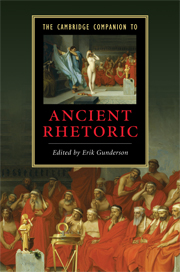Book contents
- Frontmatter
- Introduction
- Part 1 An archaeology of rhetoric
- Part II The field of language
- Part III The practice of rhetoric
- 8 Types of oratory
- 9 Rhetoric of the Athenian citizen
- 10 Rhetoric and the Roman Republic
- 11 Staging rhetoric in Athens
- 12 The drama of rhetoric at Rome
- 13 Rhetoric and the Second Sophistic
- Part IV Epilogoues
- Appendix 1: Rhetorical terms
- Appendix 2: Authors and prominent individuals
- References
- Index of passages
- Index of subjects
- Series list
8 - Types of oratory
from Part III - The practice of rhetoric
Published online by Cambridge University Press: 28 January 2010
- Frontmatter
- Introduction
- Part 1 An archaeology of rhetoric
- Part II The field of language
- Part III The practice of rhetoric
- 8 Types of oratory
- 9 Rhetoric of the Athenian citizen
- 10 Rhetoric and the Roman Republic
- 11 Staging rhetoric in Athens
- 12 The drama of rhetoric at Rome
- 13 Rhetoric and the Second Sophistic
- Part IV Epilogoues
- Appendix 1: Rhetorical terms
- Appendix 2: Authors and prominent individuals
- References
- Index of passages
- Index of subjects
- Series list
Summary
Aristotle’s Rhetoric is our first surviving work to divide oratory into three types (eidē) or species (genē): “deliberative” (sumbouleutikon); “forensic” or “dicanic” (dikanikon); “epideictic” or “display” or “demonstrative” (epideiktikon). This threefold classification is an important structuring principle in the philosopher’s attempt to establish that rhetoric is a proper “art” (tekhnē). Aristotle’s vision of rhetoric is that it be a practical discourse; an important counterpart to philosophical dialectic in a real-world setting where a speaker is seeking the best available means of persuasion in the face of mass audiences (Aristotle, Rhetoric 1358a36-b8).
Aristotle explains that there are three types of rhetorikē because there are three kinds of “hearers” of speeches (1358a37–b6): epideictic oratory is directed at the spectator (theōros), who judges the ability of the speaker. The hearer of forensic oratory judges things that have already happened while the “deliberative” hearer is a judge of things to come. Aristotle goes on to give each of the three types a distinctive mode: deliberative oratory is either hortatory or dissuasive. Forensic oratory is either accusatory or defensive. Epideictic oratory offers either praise or blame (1358b8–13). In line with the remarks on “judgment” the three types also treat different aspects of time (1358b14–19). But when it comes to epideictic oratory, Aristotle’s penchant for tidiness comes under strain: while he deals primarily with matters of the present, the display orator might also recall past events or anticipate the future.
- Type
- Chapter
- Information
- The Cambridge Companion to Ancient Rhetoric , pp. 145 - 161Publisher: Cambridge University PressPrint publication year: 2009
- 2
- Cited by



